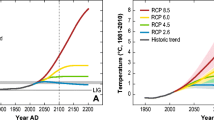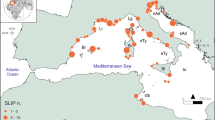Abstract
The present Cenozoic era is an ‘icehouse’ episode characterized by a low sea level. Since the beginning of the industrial revolution, the human race has been emitting greenhouse gases, increasing the global atmospheric temperature, and causing a rise in sea level. If emissions continue to increase at the present rate, average global temperatures may rise by 1.5°C by the year 2050, accompanied by a rise of about 30 cm in sea level. However, the prediction of future climatic conditions and sea level is hampered by the difficulty in modelling the interactions between the lithosphere, kryosphere, biosphere and atmosphere; in addition, the buffering capacity of our planet is still poorly understood. As scientists cannot offer unambiguous answers to simple questions, sorcerer's apprentices fill in the gaps, presenting plans to save planet without inconveniencing us.
The geological record can help us to learn about the regulation mechanisms of our planet, many of which are connected with or expressed as sea level changes. Global changes in sea level are either tectono-eustatic or glacioeustatic. Plate tectonic processes strongly control sea levels and climate in the long term. There is a strong feed-back mechanism between sea level and climate; both can influence and determine each other. Although high sea levels are a powerful climatic buffer, falling sea levels accelerate climatic accentuation, the growth of the polar ice caps and will hence amplify the drop in sea level. Important sources of fossil greenhouse gases are botanic CO2 production, CO2 released by volcanic activity, and water vapour. The latter is particularly important when the surface area of the sea increases during a rise in sea level (‘maritime greenhouse effect’). A ‘volcanogenic greenhouse effect’ (release of volcanogenic CO2) is possibly not equally important, as intense volcanic activity may take place both during icehouse episodes as well as during greenhouse episodes. The hydrosphere, land vegetation and carbonate platforms are major CO2 buffers which may both take up and release CO2. CO2 can be released from the ocean due to changes in the pCO2 caused by growth of coral reefs and by uptake of CO2-rich freshwater from karst provinces. Efficient sinks of CO2 are the weathering products of silicate rocks; long-term sinks are organic deposits caused by regional anoxic events which preferrably develop during sea level rises and highstands; and coal-bearing strata. Deposition of limestone also removes CO2 from the atmospheric-hydrospheric cycle at a long term. Biotic crises are often related to either sea-level lows or sea-level highs. Long-term sea-level lows, characteristic of glacial periods, indicate cooling as major cause of extinction. During verly long-lasting greenhouse episodes the sea level is very high, climate and circulation systems are stable and biotic crises often develop as a consequence of oxygen depletion. On land, niche-splitting, complex food web structures and general overspecialization of biota will occur. Whether the crisis is caused by a single anoxic event (e.g. in the Late Devonian) or a disturbance by an asteroid impact (e.g. the Cretaceous/Tertiary boundary), it will only trigger total collapse of an ecosystem if a large part of it was already in decline. The regulatory mechanisms and buffers are thermodynamically extremely efficient if they are given sufficient time in which to deploy their power. However, after major catastrophes the re-establishment of successful ecosystems will take millions of years. The present rate of sea level and associated temperature rise is much too fast to be compensated and buffered by the network of natural controls. It is likely that the transitional time towards a new steady state will be an extremely variable and chaotic episode of unpredictable duration.
Similar content being viewed by others
References
Adams JM, Faure H, Faure-Denard L, McGlade JM, Woodward FI (1990) Increases in terrestrial carbon storage from the last glacial maximum to the present. Nature 348: 711–714
Bach W (1984) Die CO2-induzierte Klimagefahr. Geowissensch Zeit 5: 167–175
Baggeroer A, Munk W (1992) The Heard Island feasability test. Physics Today 9: 22–30
Barrett PJ, Elston DP, Harwood DM, McKelvey BC, Webb P-N (1987) Mid-Cenozoic record of glaciation and sea-level change on the margin of the Victoria Land Basin, Antarctica. Geology 15: 634–637
Barrett PJ, Adams CJ, MacIntosh WC, Swisher CC, Wilson GS (1992) Geochronological evidence supporting antarctic deglaciation three million years ago. Nature 359: 816–818
Berger A (1988) Milankovitch theory and climate. Reviews Geophysics 26: 624–657
Berger A, Gallée H, Fichefet Th, Marsiat I, Tricot Ch (1990) Testing the astronomical theory with a coupled climate-ice sheet model. Palaeogeography, Palaeoclimatology, Palaeoecology 89: 125–141
Berger A, Fichefet Th, Gallée H, Marsiat I, Tricot Ch, van Ypersele JP (1990) Ice sheets and sea level change as a response to climatic change at the astronomical time scale. In: Paepe R et al (eds) Greenhouse effect, sea level and drought: 85–107 (Klouwer Academic Publishers)
Berger WH (1991) Produktivität des Ozeans aus geologischer Sicht: Denkmodelle und Beispiele. Z dt geol Ges 142: 149–178
Berger WH (1992) Klimageschichte aus Tiefseesedimenten. Neues vom Ontong-Java-Plateau (Westpazifik). Naturwissenschaften 79: 541–550
Bilham R, Barrientos S (1991) Sea-level rise and earthquakes. Nature: 350, 386
Blankenship DD, Bell RE, Hodge SM, Brozena JM, Behrend JC, Finn CA (1993) Active volcanism beneath the West Antarctic ice sheet and implications for ice-sheet stability. Nature 361: 526
Broecker WS, Denton GH (1990) Ursachen der Vereisungszyklen. Atmosphäre, Klima, Umwelt. Spektrum der Wissenschaft, 78–87
Chahine M (1992) The hydrological cycle and its influence on climate, Nature 359: 373–380
Chappell J, Polach H (1991) Post-glacial sea-level rise from a coral record at Huon Peninsula, Papua New Guinea. Nature 349: 147–150
Crossland CJ, Hatcher BG, Smith SV (1991) Role of coral reefs in global ocean production. Coral Reefs 10: 55–64
De Boer PL (1991) Astronomical cycles reflected in sediments. Zbl Geol Paläont, Teil I 1990: 911–930
Fischer AG, Arthur MA (1977) Secular variations in the pelagic realm. In: ‘Deep water carbonate environments’ Cook HE, Enos PE, (eds) SEPM, Spec Publ 25: 19–50
Gao G (1993) The temperatures and oxygen-isotope composition of Early Devonian oceans. Nature 361: 709–710
Ghil M, Vautard R (1991) Interdecadal oscillations and the warming trend in global temperature time series. Nature 350: 324–327
Goldammer JG (1990) Waldummandlung und Waldverbrennung in den Tiefland-Regenwäldern des Amazonasbeckens: Ursachen und ökologische Implikationen. Ber Naturf Ges Freiburg i Br 80: 119–142
Gornits V, Lebedeff S, Hansen J (1982) Global sea level trend in the past century. Science 215: 1611–1614
Haq BU (1991) Sequence stratigraphy, sea-level change, and significance for the deep sea. Int Ass Sediment Spec Publ 12: 3–39
Haq BU, Hardenbol J, Vail PR (1988) Mesozoic and Cenozoic chronostratigraphy and cycles of sea-level change. Spec Publ Soc Econ Paleontol Mineral No 42: 71–108
Hay W W (1992) The cause of the late Cenozoic northern hemisphere glaciations: a climate change enigma. Terra Nova 4: 305–311
Hayes JD, Imbrie J, Shackleton NJ (1976) Variations in the erath's orbit: pacemaker of the ice ages. Science 194: 1121–1132
Hofmann DJ (1991) Aircraft sulphur emissions. Nature 349: 659
Imbrie J, Imbrie KP (1979) Ice Ages: Solving the mystery. Enslow, Short Hills, N-J
Jacobs DK, Sahagian DL (1993) Climate-induced fluctuations in sea level during nonglacvial times. Nature 361: 710–712
Johnsen SJ, Clausen HB, Dansgaard W, Fuhrer K, Gundestrup N, Hammer CU, Iversen P, Jouzel J, Stauffer B, Steffensen JP (1992) Irregular glacial interstadials recorded in a new Greenland ice core. Nature 359: 311
Jones D (1990) Firefighting foam. Nature 348: 396
Joos F, Sarmiento JL, Siegenthaler U (1991) Estimates of the effect of southern ocean iron fertilization on atmospheric CO2 concentrations. Nature 349: 772–776
Keir RS (1991) Ironing out greenhouse effects. Nature 349: 198
Keith DW, Dowlatabadi H (1992) A serious look at geoengineering. EOS 73: 289–293
Keller G, Zenker CE, Stonne SM (1989) Late Neogene history of the Pacific-Carribbean gateway. J South Amer Earth Sci 2: 73–108
Lambeck K (1990) Late Pleistocene, Holocene, and present sealevels: constraints on future change. Palaeogeography, Palaeoclimatology, Palaeoecology 89: 205–217
Leinfelder RR. Upper Jurassic reef types and controlling factors. A preliminary report. Profil 5: (in press)
Leinfelder RR, Krautter M, Nose M, Ramalho MM, Werner W. Siliceous sponge facies from the Upper Jurassic of Portugal. N Jahrb Geol Paläontol, Abh 189 (in press)
Macdonald DIM (1991) Preface. Int Assoc Sediment, Spec Publ No 12: ix-x
Marsiat IM, Berger A (1990) On the relationship between ice volume and sea level over the last glacial cycle. Climate Dynamics 4: 81- 84
Martin H (1992) Menschheit auf dem Prüfstand. Einsichten aus 4,5 Milliarden Jahren Erd-, Lebens- und Menschheitsgeschichte. Springer, Berlin Heidelberg New York: 407 pp.
Meier MF (1990) Reduced rise in sea-level. Nature 343: 115–116
Mikolajewicz U, Sauter B, Meier-Reimer E (1990) Nature 345: 589
North GR, Crowley TJ (1985) Application of a seasonal climate model to Cenozoic glaciation. J geol Soc London 142: 475–482
Oechel WC, Hastings SJ, Vourlitis G, Jenkins M, Riechers G, Grulke N (1993) Recent change of Arctic tundra ecosystems from a net carbon dioxide sink to a source. Nature, 361: 520–523
Oschmann W (1990) Environmental cycles in the late Jurassic northwest European epeiric basin: interaction with atmospheric and hydrospheric circulation. Sedim Geol 69: 313–332
Pitman WC III (1979) The effect of eustatic sea level changes on stratigraphic sequences at Atlantic margins. Am Assoc Petrol Geol Mem No 29: 453–460
Prentice ML, Matthews RK (1988) Cenozoic ice-volume history: Development of a composite oxygen isotope record. Geology 16: 963–966
Rampino MR (1991) Volcanism, climatic change, and the geologic record. Spec Publ Soc Econ Paleontol Mineral No 45: 9–18
Rampino MR, Self S (1992) Volcanic winter and accelerated glaciation following the Toba super-eruption. Nature 359: 50
Raymo ME, Ruddiman WF (1992) Tectonic forcing of late Cenozoic climate. Nature 359: 117–122
Ross CA, Moore GT, Hayashida DN (1992) Late Jurassic paleoclimate simulation — paleoecological implications for ammonoid provinciality. Palaios 7: 487–507
Schlesinger ME, Jiang X. (1991) Revised projection of future greenhouse warming. Nature 350: 219–222
Seyfried H, Astorga A, Amann H, Calvo C, Kolb W, Schmidt H, Winsemann J (1991) Anatomy of an evolving island arc: tectonic and eustatic control in the south Central American fore-arc area. Spec Publ Int Assoc Sedimentol, No 12: 217–240
Smith TM, Shugart HH (1993) The transient response of terrestrial carbon storage to a perturbed climate. Nature 361: 523–526
Sudgen D (1992) Antarctic ice sheets at risk? Nature 359: 775–776
Vail PR, Hardenbol J (1979) Sea-level changes during the Tertiary. Oceanus 22: 71–79
Vail PR, Sangree JB (1988) Sequence stratigraphy concepts. — Short course in conjunction with the conference Sequence, Stratigraphy, Sedimentology: Surface and Subsurface' Course Notes, Can Soc Petrol Geol, Calgary
Vail PR, Mitchum RM Jr, Todd RG, Widmeier JM, Thompson S III, Sangree JB, Bubb JN, Hatledid WG (1977) Seismic Stratigraphy and global changes of sea-level: Amer Assoc Petrol Geol, Mem 26: 49–212
van Campo E, Duplessy JC, Prell WL, Barratt N, Sabatier R (1990) Comparison of terrestrial and marine temperature estimates from the past 135 kyr off southeast Africa: a test for GCM simulations of palaeoclimate. Nature 348: 209–212
Valdes PJ, Sellwood BW (1992) A palaeoclimate model for the Kimmeridgian. Palaeogeogr Palaeoclimatol Palaeoecol 95: 47–72
Ware JR, Smith SV, Reaka-Kudla ML (1992) Coral reefs: sources or sinks of atmospheric CO2? Coral Reefs 11: 127–130
Webb RS, Overpeck JT (1993) Carbon reserves released? Nature 361: 497
Wefer G (1991) Stofftransport zum Meeresboden: Eine Übersicht. Naturwissenschaften 78: 1–6
Woelfli W (1993) Beschleunigermassenspektrometrie und Umweltforschung. Vierteljahresschrift Naturforsch Ges Zürich 138: 37–66
Woodwell GM (1990) Das Kohlendioxid-Problem. Atmosphäre, Klima, Umwelt. Spektrum der Wissenschaft: 168–177
World Resources Institute (1992) World resources 1992–1993. Oxford University Press, New York: 385 p
Author information
Authors and Affiliations
Additional information
Correspondence to: H. Seyfried
Rights and permissions
About this article
Cite this article
Leinfelder, R., Seyfried, H. Sea level change: a philosophical approach. Geol Rundsch 82, 159–172 (1993). https://doi.org/10.1007/BF00191822
Received:
Accepted:
Issue Date:
DOI: https://doi.org/10.1007/BF00191822




